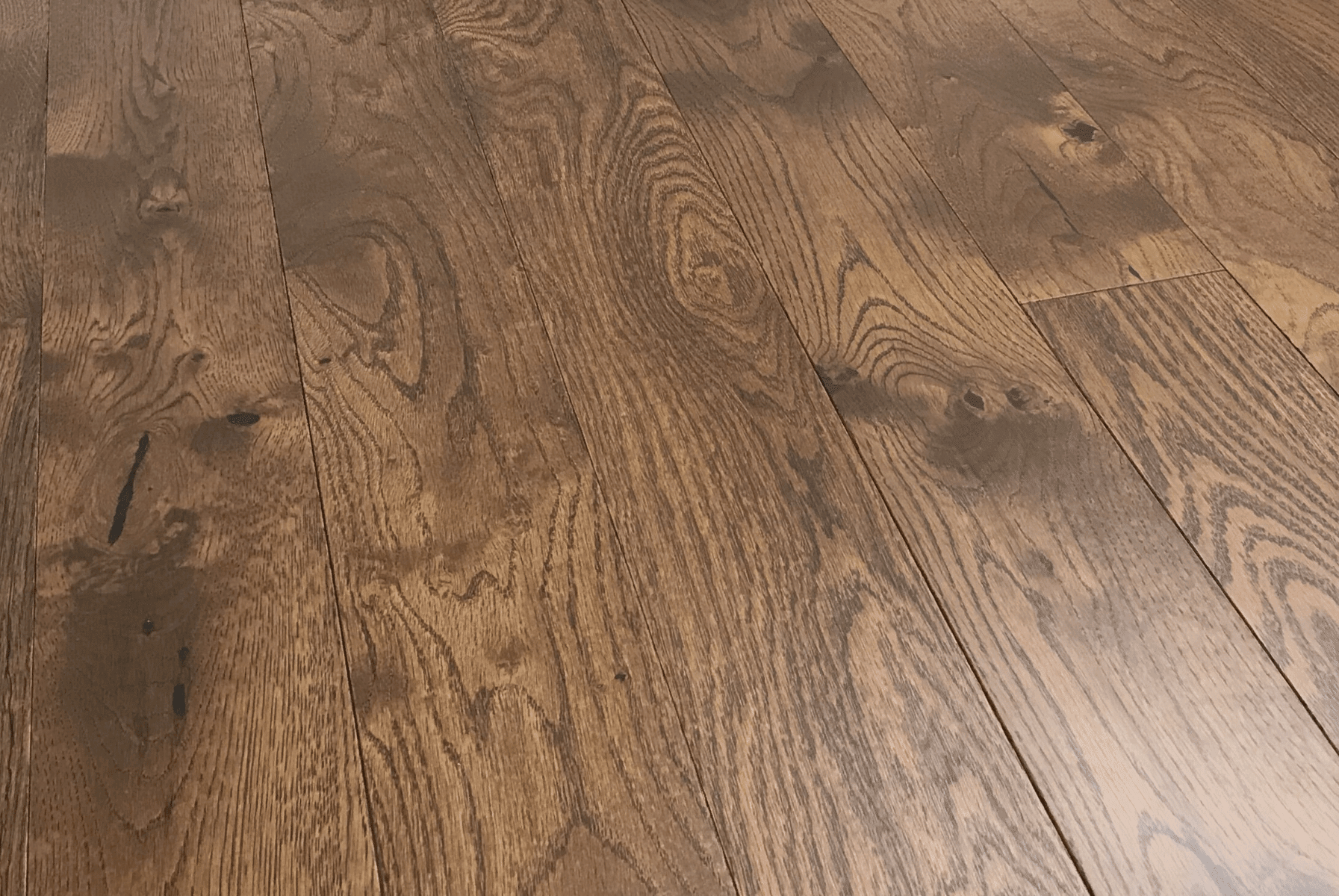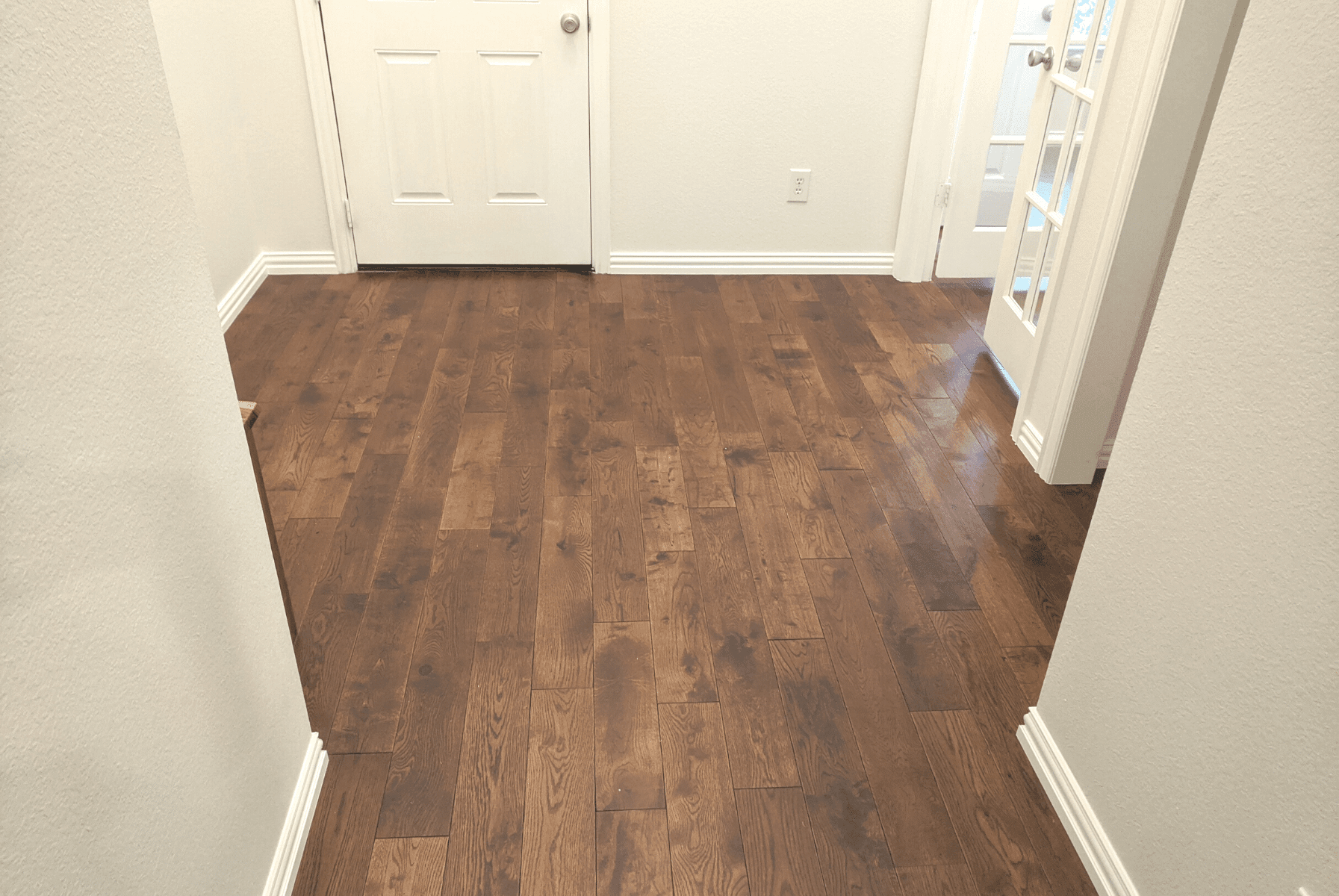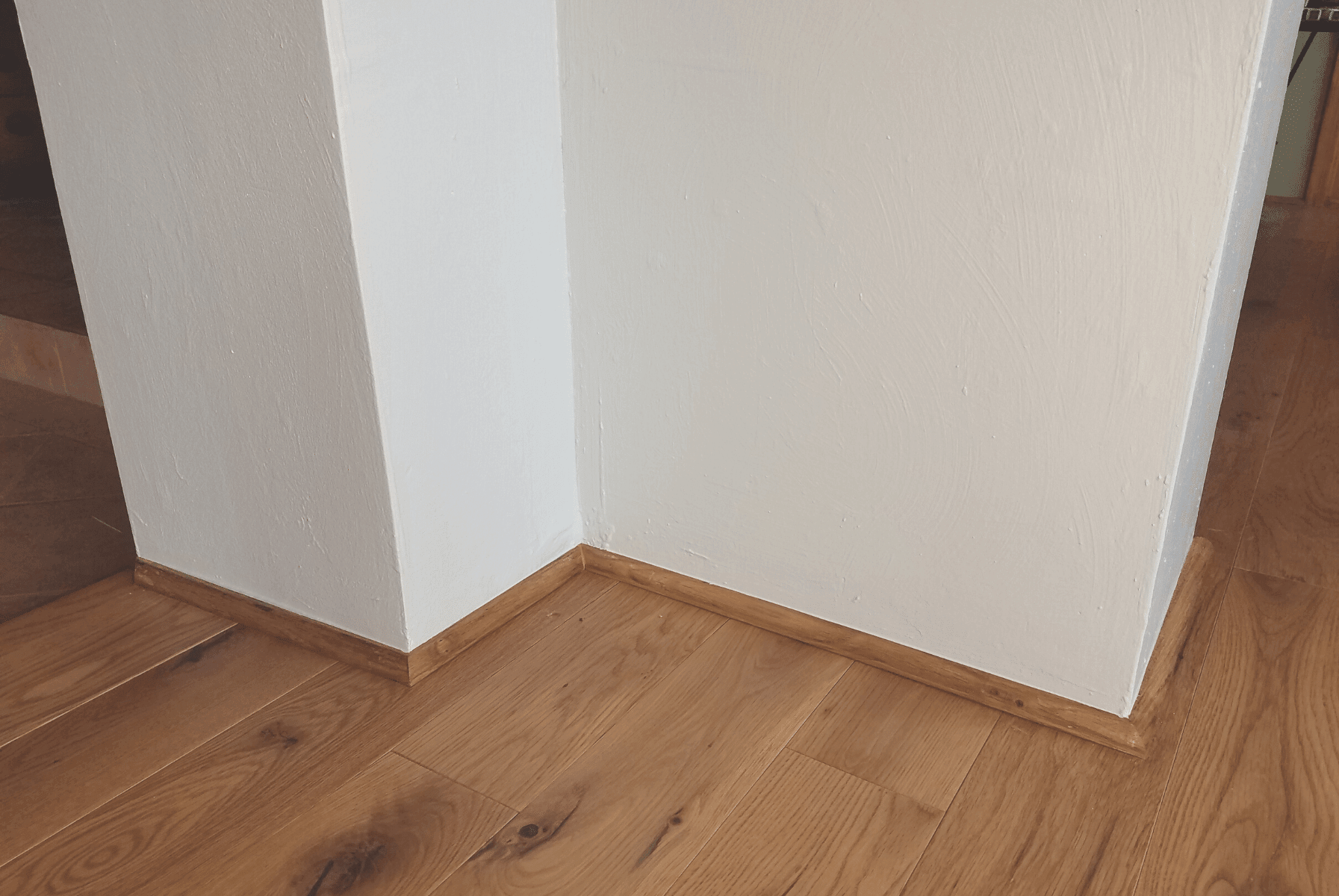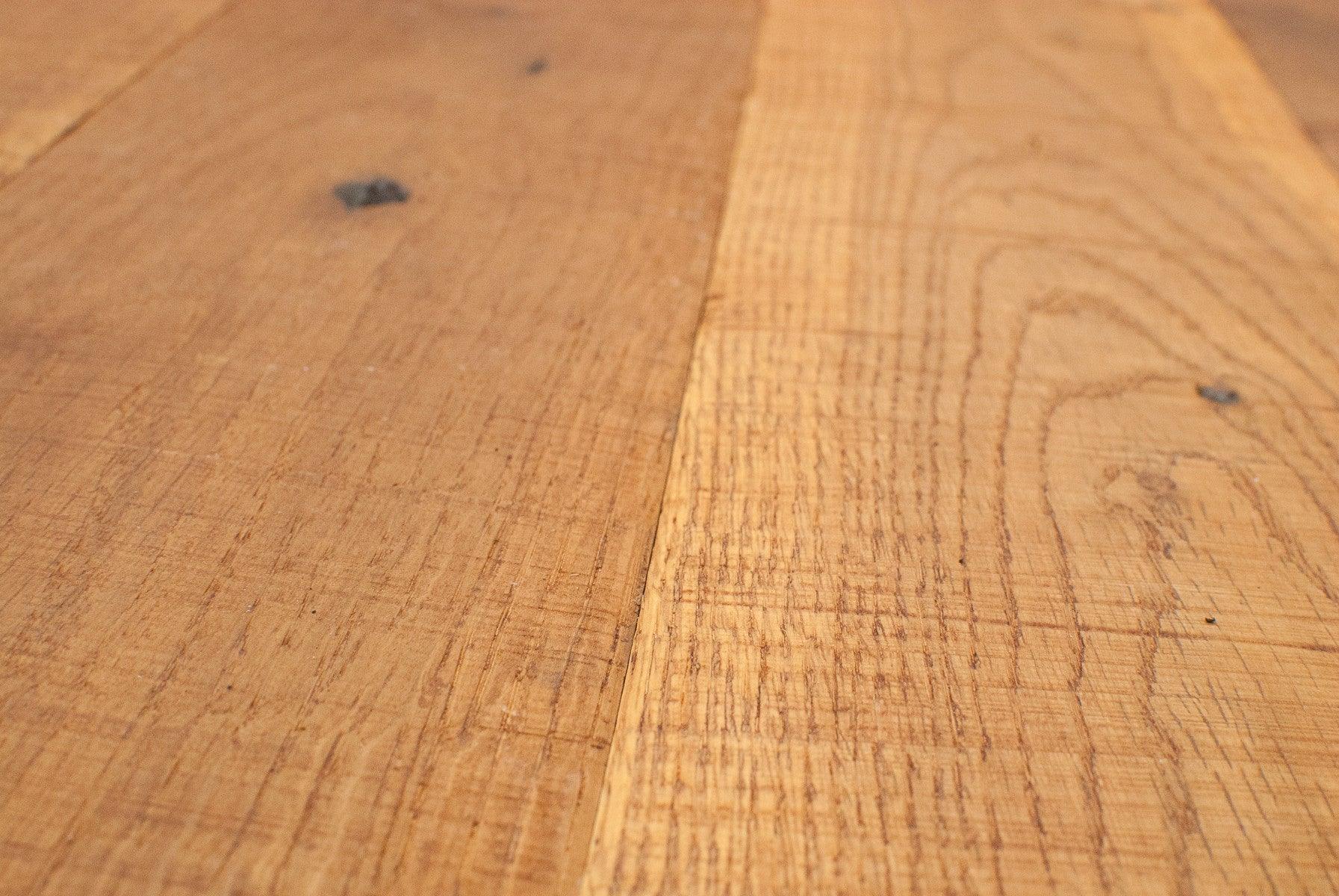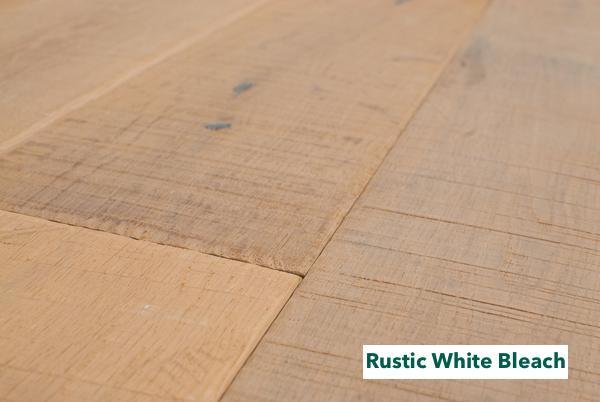Your hardwood floors are beautiful—but they’re also sensitive. Like your skin in dry winter air or your lungs on a humid summer day, wood reacts to the surrounding environment. Too much or too little moisture in your home’s air can cause gapping, cupping, crowning, or even full-on buckling in your hardwood floors.
Whether you live in the wet Pacific Northwest or the dry Canadian Prairies, maintaining the right indoor humidity is key to protecting your floor’s look, feel, and longevity.
Let’s explore how humidity affects your floors, what to watch for, and what you can do to fix and prevent moisture problems.

What Is the Ideal Humidity for Hardwood Floors?
In non-scientific terms, relative humidity (RH) is how much water is in the air. Dew point is when the air is 100% saturated at a given temperature. When you see dew on the grass in the morning, it means that the temperature dropped to a level that made the RH 100% and the water vapor turned back to a liquid.
Wood flooring should have indoor humidity levels of between 35% to 45%. It’s the same as for us. To put it into perspective, the humidity levels in Florida frequently hover in the high 90% range while the humidity in Las Vegas can go as low as 18%. From Portland, Oregon to Portland, Maine, one can experience high humidity in every state.
However, the outside RH and indoor humidity levels can vary dramatically, especially during the heating season. As you heat cold, outside air, the RH drops significantly.
High or low indoor humidity can damage the floor in different ways.

How Humidity Affects Your Hardwood Floors
Think about when you’ve experienced a hot, muggy day. You are miserable outside, and you look for the nearest air-conditioned room. Why? Because air-conditioning lowers the temperature and the humidity to a comfortable level.
Conversely, if you’ve ever experienced an arid climate like on top of a mountain or a desert in summer, you know that your throat feels dry and your skin can start to itch from dehydration.
Hardwood floors can undergo stress from the same extremes of humidity when the internal environment does not have proper humidity regulation.
1. Gaps and Seams Between Boards
In areas where homes need to heat during winter months, the humidity levels drop dramatically. If you’ve experienced static electric shocks from walking on the carpet, that’s a sign of very low humidity. A home heated in winter can plummet to just 15%. That’s bad news for your skin and your hardwood floors. The cracks between the boards of a new hardwood floor are almost invisible. However, as the humidity drops during the heating season, the moisture evaporates from the wood, causing it to shrink and the seams to open wider. In some cases, they can open as much as a 1/8th of an inch (3.2 mm) or more, making the floor look unfinished or poorly laid.
(Wood floor planks shrink in overly dry humidity, causing gaps between floor planks)
To avoid the problem, you’ll need to install a humidifier. Whether you need a room size or humidifier for the entire home depends on the size of the house, flooring and heating area.
2. Cupping and Crowning
Too much indoor humidity for an extended period will create the adverse effects of cupping and crowning.
Wood floor cupping, as the name suggests, is a condition where the edges of floorboards curl upward. The edges are higher than the center making the board look like a cup, creating an unsightly tripping hazard. Crowning is the opposite condition where the center expands upward, and the edges remain flat.
With cupping, moisture from humidity or spills absorbs into the wood causing it to swell, pushing the edges tightly together and upward. To reverse the effects, use a floor fan to dry the floor and a dehumidifier to control the humidity.
Causes of crowning are excess moisture from humidity, spills or wicking moisture from the sub-floor. Another reason can be sanding the floor too soon before the floor was completely dry. High humidity will swell the center, so controlling the moisture with a dehumidifier is the solution.

3. Buckling from Extreme Moisture
This is a relatively rare but severe condition usually caused by an extreme event such as flooding. A buckled floor pulls away from the subfloor several inches and the boards can look like skis. As heartbreaking as it is, the boards can dry, and you can repair them if time allows. Otherwise, replacement is the only option.
Preventing Hardwood Floor Moisture Problems
Other than moving out of a flood zone, preventing moisture problems is relatively simple. Here are a few tips:
- Continuously monitor your home’s humidity with a digital hygrometer.
- NEVER use a soaking wet mop on your hardwood floors!
- ALWAYS clean up spills immediately!
- Install an appropriate humidifier during heating season or areas of low humidity.
- Install a dehumidifier if your room exceeds more than 50% RH for more than a few days.
- Clean your hardwood floors with products approved by the manufacturer.
- Never use water-based products.
Controlling the humidity in every room is critical to preventing problems with moisture ruining your beautiful hardwood floors. In climates with four seasons, it’s a good idea to invest in a digital hygrometer, a humidifier, and a dehumidifier to maintain humidity equilibrium throughout the year.

Tools to Monitor Humidity (and Why They Matter)
Before you begin installing a hardwood floor, make a small investment in a quality digital hygrometer. They measure the amount of moisture in the air.
The best living conditions for you are also best for your floors. Most people are comfortable with a room temperature between 65-75⁰ F (18-24⁰ C) and relative humidity between 30-45%. To give this some context, the relative humidity in the Sahara Desert is around 25% while the average home, heated in the dead of winter can be as low as 13%. Most hardwood floor manufacturers recommend a humidity level of around 35%.
A digital hygrometer has an easy to read display like a clock, and it will tell you whether you need to turn on the humidifier or de-humidifier. You can even get a hygrometer app for your phone. It’s an early warning system against long-term moisture problems for your floors, furniture, and health.
Manufacturers recommend acclimating the boards for 3 to 5 days in the room before installing the floors. By maintaining a regulated level of humidity, the boards will absorb the same amount of moisture and make for a better installation.
How to Regulate Humidity for Hardwood Floors
The humidity in your home is always fluctuating. The three sources come from the ground, the air and internally from showers and cooking.
Depending on your home’s location and needs, there are two ways to control it.
1. Humidifying for Comfort
Adding moisture to your internal spaces is the job of a humidifier. You can humidify the entire home or just one room.
- Furnace Humidifier – A whole house humidifier connects to the furnace and allows water to evaporate into the heated air that circulates throughout the house.
- Room Humidifier – If you only need to humidify a room, an ultrasonic humidifier can do the job without heating the water into steam.
Compare models to determine the coverage and amount of moisture they produce.
 2. Dehumidify to Reduce Mold and Other Issues
2. Dehumidify to Reduce Mold and Other Issues
Excess moisture is not only detrimental for wood floors but everyone’s health. Mold can grow inside of floors, walls and ceiling spaces. Installing hardwood floors in basements or over crawl spaces can be challenging unless you have a dehumidifier working. Dehumidifiers, like humidifiers, can be attached to the central heat and air conditioning unit or portable for use in one room.
Use a moisture meter to check the floor’s moisture content frequently and also keep an eye on the digital hygrometer during the wet months.
Use a Home Humidity Levels Chart
A home humidity levels chart helps you visualize the amount of humidity on any given day. For example, take a cold winter’s day when the outside temperature is 10⁰F (-12⁰C), and the outside RH is 70%. Viewing the chart, we can observe that the RH drops to only 6% when the air enters the heated home. As cold outside air becomes heated, the humidity drops dramatically.


Monitor and Regulate Your Home’s Humidity Levels
Maintaining the right humidity for hardwood floors will keep them beautiful for years to come. Solid hardwood floors expand in high humidity and shrink in low humidity conditions. If you live in an area of dry winters and muggy, hot summers, monitoring and controlling indoor humidity will preserve your floors and your health.
Use a thermo hygrometer to keep an eye on your indoor humidity level. Install humidifiers and dehumidifiers for comfort and to prevent hardwood floor cupping or cracking. There's lots more great advice on home indoor air quality and humidity management at Home Air Advisor.
Protect Your Hardwood Floors by Controlling Humidity Year-Round
Your hardwood floors are one of the biggest visual statements in your home—don’t let humidity ruin them. By tracking indoor air moisture with a digital hygrometer and using the right tools to regulate it, you’ll preserve your investment and your comfort.
Whether you’re preventing gaps in January or fighting excess moisture in July, humidity control is the secret to long-lasting hardwood.
Shop Easiklip’s solid white oak flooring for a floating hardwood system that’s moisture-conscious, DIY-friendly, and engineered for Canadian climates.
▶️ Explore our collections now at www.easiklip.com






